Airport Pavement Maintenance Decision-Making System with Condition Cases Optimization
Abstract
:1. Introduction
2. Airport Pavement Management System Architecture
2.1. System Architecture
2.2. Condition Index: Serviceability Level (SL)
2.3. SL Performance Curve
2.4. Decision Making Process for Airport Pavement Management System
2.4.1. Determination of Cost and Effect for M&R Methods
2.4.2. Benefit
2.4.3. Optimization Method
2.4.4. Sensitivity Analysis
3. Case Study
4. Conclusions
Author Contributions
Funding
Institutional Review Board Statement
Informed Consent Statement
Data Availability Statement
Conflicts of Interest
References
- Federal Aviation Administration. Advisory Circular No. 150/5380-6C Guidelines and Procedures for Maintenance of Airport Pavements; FAA: Washington, DC, USA, 2014. Available online: https://www.faa.gov/regulations_policies/advisory_circulars/index.cfm/go/document.information/documentID/1026067 (accessed on 10 October 2014).
- Karballaeezadeh, N.; Zaremotekhases, F.; Shamshirband, S.; Mosavi, A.; Nabipour, N.; Csiba, P.; Várkonyi-Kóczy, A.R. Intelligent Road Inspection with Advanced Machine Learning; Hybrid Prediction Models for Smart Mobility and Transportation Maintenance Systems. Energies 2020, 13, 1718. [Google Scholar] [CrossRef]
- Federal Aviation Administration. Advisory Circular No. 150/5320-6G Airport Pavement Design and Evaluation; FAA: Washington, DC, USA, 2021. Available online: https://www.faa.gov/airports/resources/advisory_circulars/index.cfm/go/document.current/documentnumber/150_5320-6 (accessed on 7 June 2021).
- Hachiya, Y.; Watanabe, T.; Kanno, M. Development of Airport Pavement Optimal Rehabilitation Timing System and Its Application to Airports in Japan. In Airfield and Highway Pavement 2013: Sustainable and Efficient Pavements; ASCE: Reston, VA, USA, 2013; pp. 640–649. [Google Scholar] [CrossRef]
- Laguado Lancheros, J.; Wolfert, A.R.M.; van Nederveen, G.A.; Koutamanis, A.; Mooren, F. Airport Pavement Management Decision Making: A Prioritization Tool to Select Pavement Sections Requiring M&R Treatment. Master’s Thesis, Delft University of Technology, Delft, The Netherlands, 2018. [Google Scholar]
- Di Mascio, P.; Moretti, L. Implementation of a pavement management system for maintenance and rehabilitation of airport surfaces. Case Stud. Constr. Mater. 2019, 11, e00251. [Google Scholar] [CrossRef]
- International Civil Aviation Organization. Doc 9157 Aerodrome Design Manual Part 3—Pavements; ICAO: Montreal, QC, Canada, 2022. [Google Scholar]
- Fwa, T.F.; Chan, W.T.; Hoque, K.Z. Multi objective optimization for pavement maintenance programming. J. Transp. Eng. 2000, 126, 367–374. [Google Scholar] [CrossRef]
- Li, D.-F.; Yang, J.-B. Fuzzy linear programming technique for multiattribute group decision making in fuzzy environments. Inf. Sci. 2004, 158, 263–275. [Google Scholar] [CrossRef]
- Golabi, K.; Kulkarni, R.B.; Way, G.B. A statewide pavement management system. Interfaces 1982, 12, 5–21. [Google Scholar] [CrossRef]
- Hudson, W.R.; Haas, R.; Uddin, W. Infrastructure Management; McGraw: New York, NY, USA, 1997. [Google Scholar]
- Mahmood, M.S. Network-Level Maintenance Decisions for Flexible Pavement Using a Soft Computing-Based FRAMEWORK. Ph.D. Thesis, Nottignham Trent University, Nottignham, UK, 2015. [Google Scholar]
- Augeri, M.G.; Colombrita, R.; Greco, S.; Lo Certo, A.; Matarazzo, B.; Slowinski, R. Dominance-based rough set approach to budget allocation in highway maintenance activities. J. Infrastruct. Syst. 2011, 17, 75–85. [Google Scholar] [CrossRef]
- Chou, J.S. Applying AHP-based CBR to estimate pavement maintenance cost. Tsinghua Sci. Technol. 2008, 13, 114–120. [Google Scholar] [CrossRef]
- Pantha, B.R.; Yatabe, R.; Bhandary, N.P. GIS-based highway maintenance prioritization model: An integrated approach for highway maintenance in Nepal mountains. J. Transp. Geogr. 2010, 18, 426–433. [Google Scholar] [CrossRef]
- Hugo, F.; Scholtz, W.J.; Sinclair, M.; Curtayne, P.C. Management of pavement rehabilitation. Eur. J. Oper. Res. 1989, 42, 129–141. [Google Scholar] [CrossRef]
- de la Garza, J.M.; Akyildiz, S.; Bish, D.R.; Krueger, D.A. Network-level optimization of pavement maintenance renewal strategies. Adv. Eng. Inform. 2011, 25, 699–712. [Google Scholar] [CrossRef]
- Wu, Z.; Flintsch, G.W.; Chowdhury, T. Hybrid multiobjective optimization model for regional pavement-preservation resource allocation. Transp. Res. Rec. 2008, 2084, 28–37. [Google Scholar] [CrossRef]
- Ouyang, Y.; Madanat, S. Optimal scheduling of rehabilitation activities for multiple pavement facilities: Exact and approximate solutions. Transp. Res. Part A Policy Pract. 2004, 38, 347–365. [Google Scholar] [CrossRef]
- Priya, S.; Uthra, R.A. Deep learning framework for handling concept drift and class imbalanced complex decision-making on streaming data. Complex Intell. Syst. 2021, 9, 3499–3515. [Google Scholar] [CrossRef]
- Hwasoo, Y.; Yoonjin, Y.; Samer, M. Algorithms for bottom-up maintenance optimisation for heterogeneous infrastructure systems. Struct. Infrastruct. Eng. 2012, 9, 317–328. [Google Scholar] [CrossRef]
- Lee, J.; Madanat, S. Jointly optimal policies for pavement maintenance, resurfacing and reconstruction. Euro J. Transp. Logist. 2015, 4, 75–95. [Google Scholar] [CrossRef]
- Timothy, P.; Scott, M. Validation of FAA-Proposed Airport Pavement Serviceability Level Index Components. In Proceedings of the Transportation Research Board 2023 Annual Meething, Washington, DC, USA, 11 May 2023. [Google Scholar] [CrossRef]
- Korea Airports Corporation. Development of Serviceability Level and Improvement of Back-Calculation; Research Project Report; KAC: Seoul, Republic of Korea, 2019. [Google Scholar]
- Mahmoodzadeh, S.; Shahrabi, J.; Pariazar, M.; Zaeri, M.S. Project selection by using fuzzy AHP and TOPSIS technique. Int. J. Ind. Manuf. Eng. 2007, 1, 270–275. [Google Scholar]
- Pedigo, R.D.; Roberts, F.L.; Hudson, W.R.; Haas, R.C. Pavement Management: The Network-Level Decision Process (Abridgment). Transp. Res. Rec. 1980, 766, 1–5. [Google Scholar]
- Hill, L.; Cheetham, A.; Hass, R. Development and implementation of a pavement management system for Minnesota. Transp. Res. Rec. 1991, 1311, 230–241. [Google Scholar]
- Airport Cooperative Research Program. ACRP Synthesis 22 Common Airport Pavement Maintenance Practices; Transportation Research Board: Washinton, DC, USA, 2011. [Google Scholar] [CrossRef]
- Noruzoliaee, M.; Zou, B. Airfield Infrastructure Management Using Network-Level Optimization and Stochastic Duration Modeling. Infrastructures 2019, 4, 2. [Google Scholar] [CrossRef]
- Barua, L.; Zou, B. Planning maintenance and rehabilitation activities for airport pavements: A combined supervised machine learning and reinforcement learning approach. Int. J. Transp. Sci. Technol. 2022, 11, 423–435. [Google Scholar] [CrossRef]
- Hosseini, S.A.; Smadi, O. How Prediction Accuracy Can Affect the Decision-Making Process in Pavement Management System. Infrastructures 2021, 6, 28. [Google Scholar] [CrossRef]
- Korea Expressway Corporation. Korea Expressway Design and Evaluation Guidelines; KEC: Seoul, Republic of Korea, 2021. [Google Scholar]
- Korea Airports Corporation. Upgrade of Korean Airport Management System (KAPMS); Research Project Report; KAC: Seoul, Republic of Korea, 2010. [Google Scholar]
- Korea Airports Corporation. Analytical Logic Improvement Research for Upgrading Airport Pavement Management System (APMS); Research Project Report; KAC: Seoul, Republic of Korea, 2022. [Google Scholar]
- Lim, Y.H. Improvement of Project Level PMS and Development of Network Level PMS of National Highway in Korea. Ph.D. Thesis, Chung-Ang University, Seoul, Republic of Korea, 2003. [Google Scholar]
- Irfan, M.; Khurshid, M.B.; Iqbal, S.; Khan, A. Framework for airfield pavements management—An approach based on cost-effectiveness analysis. Eur. Transp. Res. Rev. 2015, 7, 13. [Google Scholar] [CrossRef]
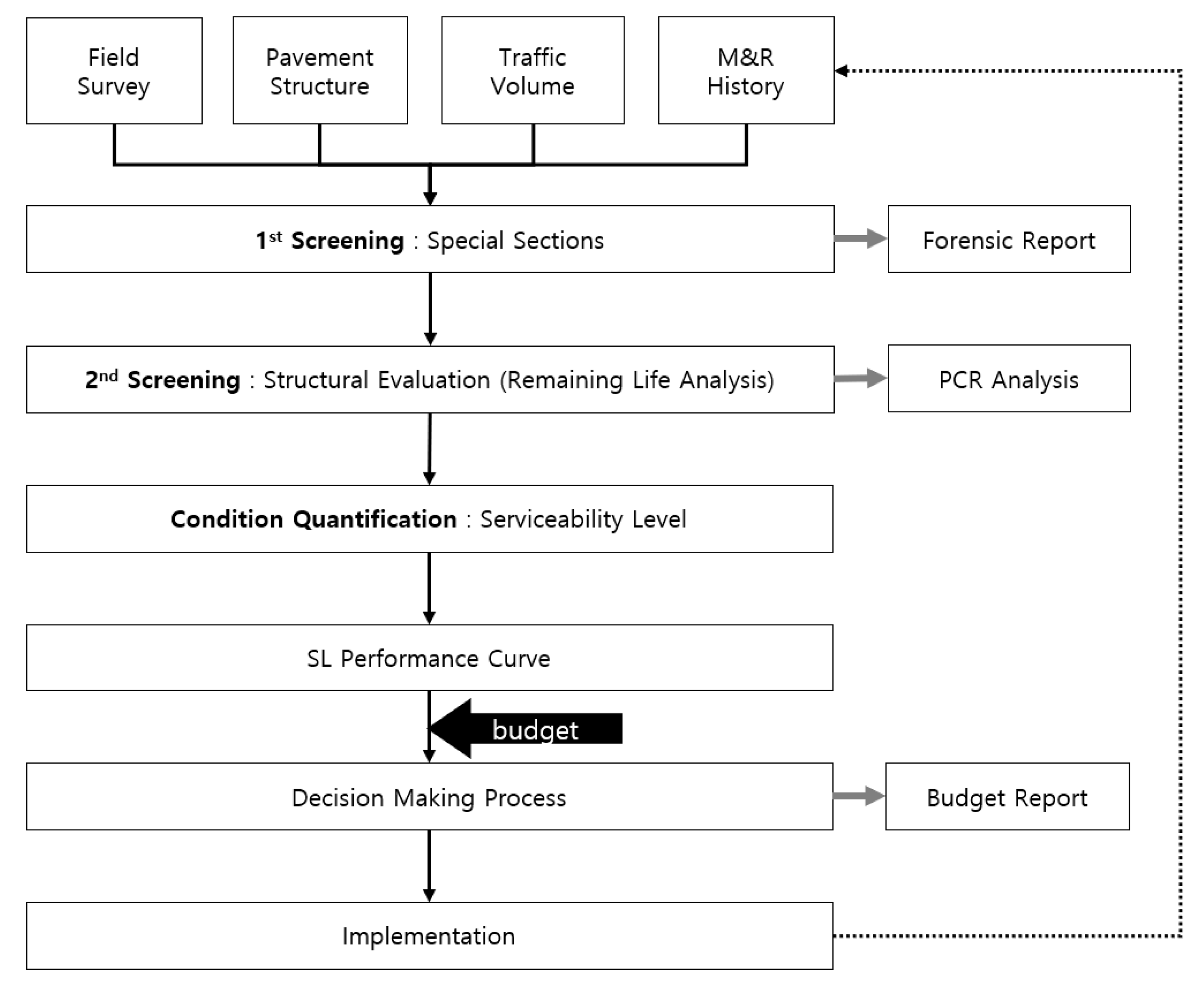
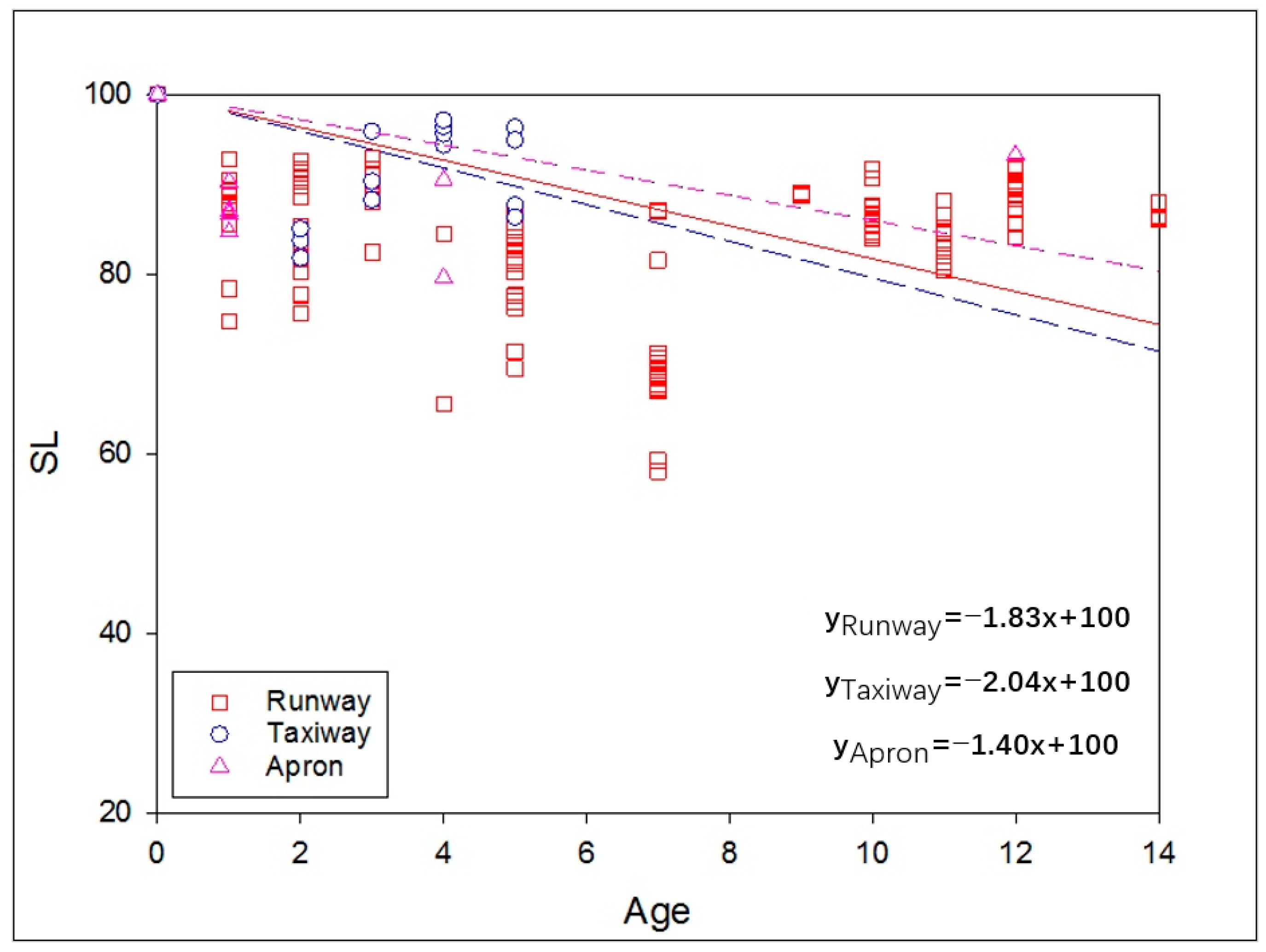

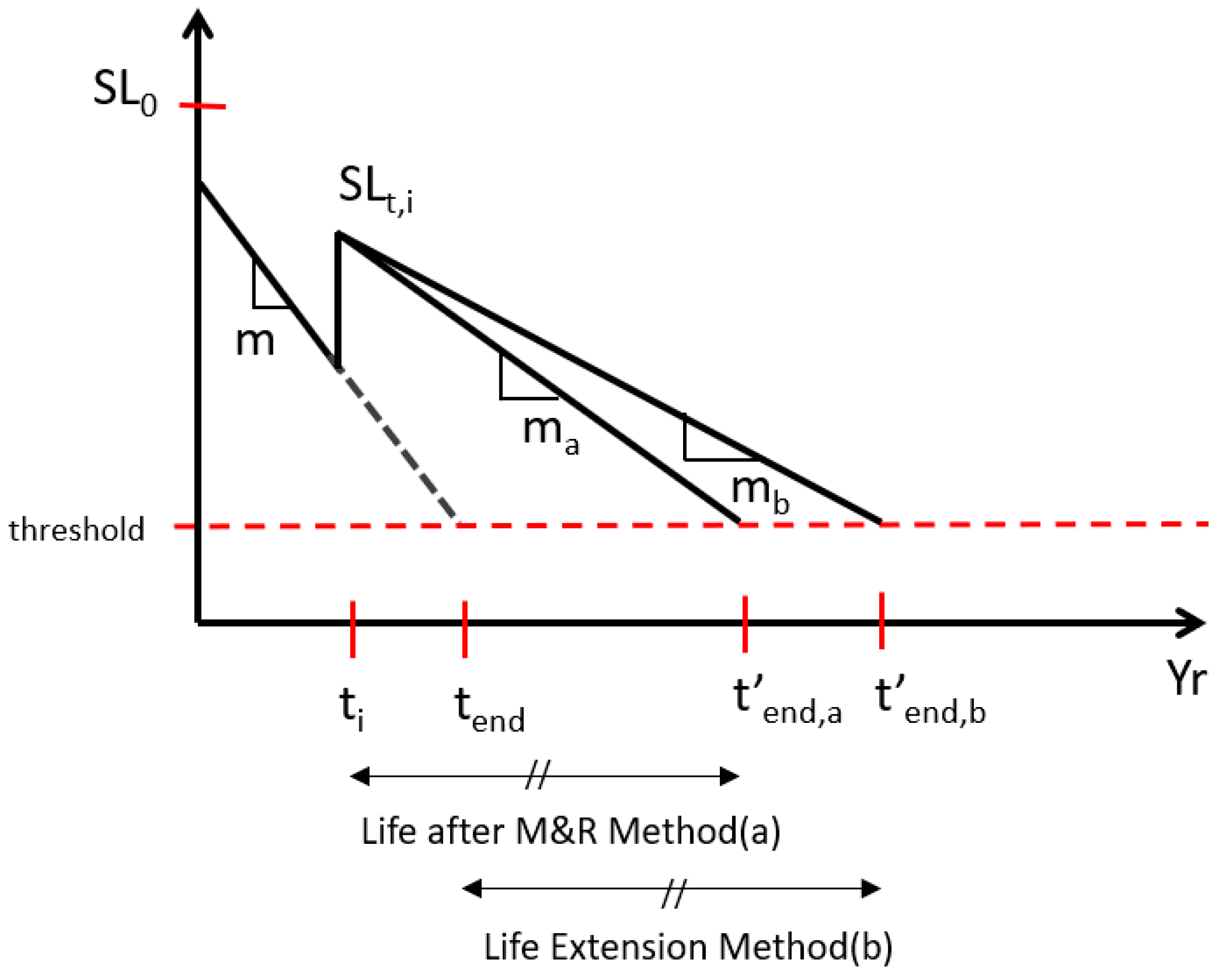
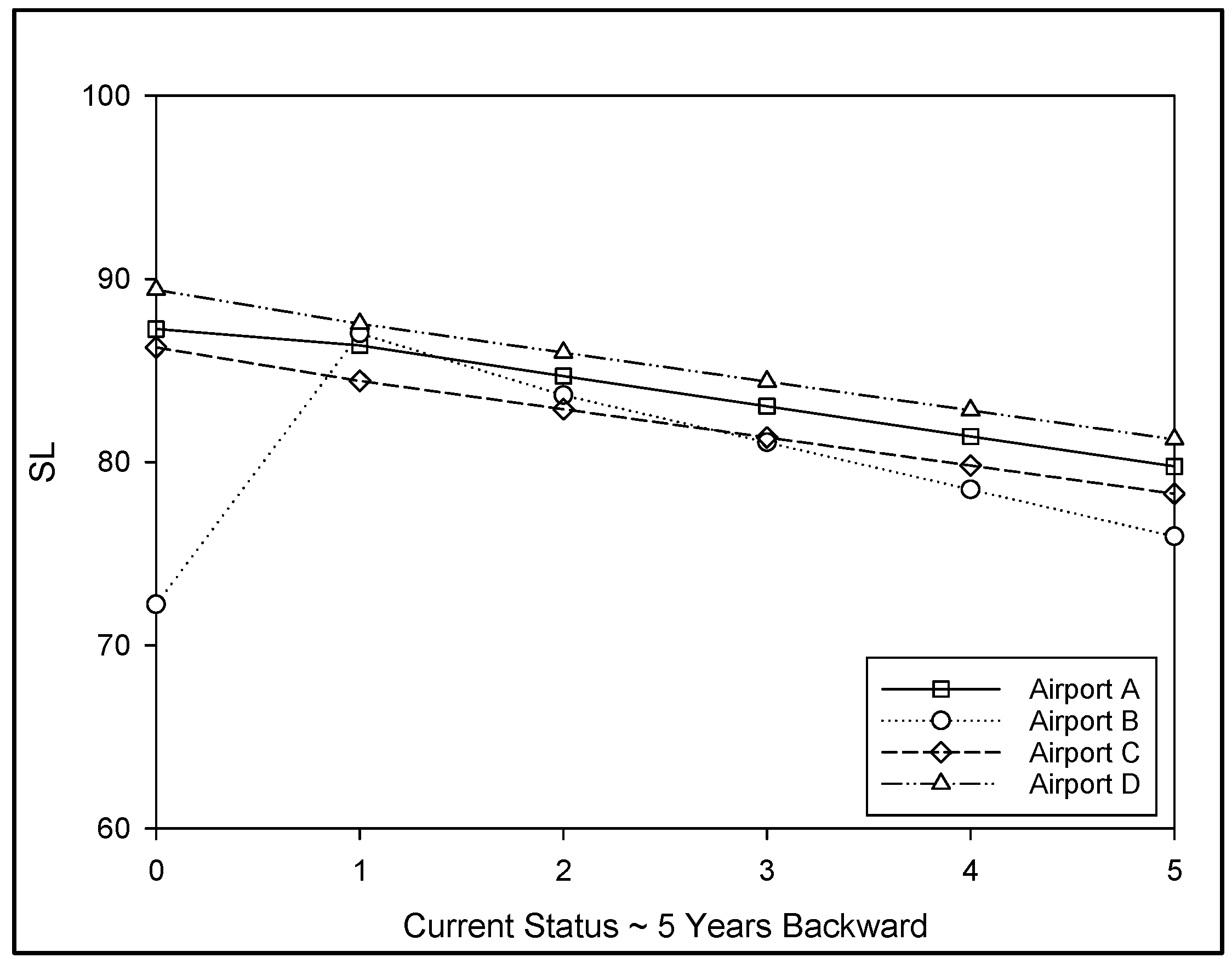
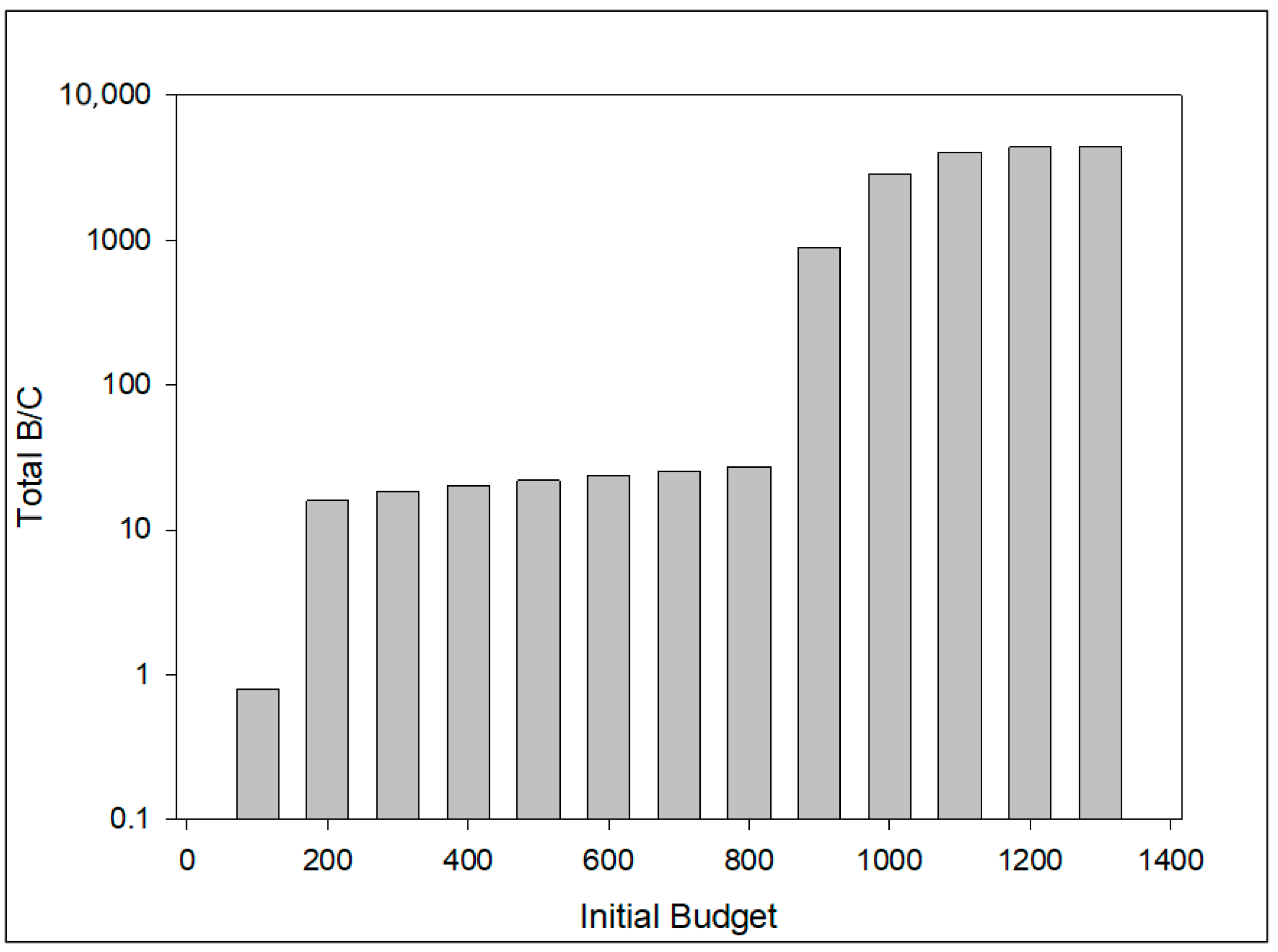
| Category | Alternatives | Unit Cost (USD/m2) | SL after Implementation | Life Extension (Year) | ||
|---|---|---|---|---|---|---|
| 1st | 2nd | 3rd | ||||
| Reconstruction | Reconstruction | 105.75 | 100 | 30 | - | - |
| Major Rehabilitation | 15 cm M/OL * | 78.96 | 95 | 10 | 6 | 4 |
| 7.5 cm M/OL * | 56.40 | 8 | 4.8 | 3.2 | ||
| 5 cm M/OL * | 47.00 | 5 | 3 | 2 | ||
| Preventive Maintenance | Patching | 58.75 | - | 3.5 | - | - |
| Slrry seal | 16.45 | 4 | - | - | ||
| Fog seal | 9.40 | 3 | - | - | ||
| Crack sealing | 2.35 | 2 | - | - | ||
| Number of Runways | 1 | 2 | 3 or More | ||||||
|---|---|---|---|---|---|---|---|---|---|
| Traffic Volume | High | Med | Low | High | Med | Low | High | Med | Low |
| λ | 0.2 | 0.3 | 0.4 | 0.6 | 0.7 | 0.7 | 0.8 | 0.8 | 0.9 |
| 1 − λ | 0.8 | 0.7 | 0.6 | 0.4 | 0.3 | 0.3 | 0.2 | 0.2 | 0.1 |
| Variables | Negative | Original Value | Positive | ||
|---|---|---|---|---|---|
| SL threshold | 50 | 65 | 80 | ||
| Initial Budget (USD) | 800 | 900 | 1000 | 1100 | 1200 |
| Analysis Period (year) | 5 | 7 | 10 | ||
| Life Extension (%) | −20% | Refer Table 1 | +20% | ||
| M&R Cost | −20% | Refer Table 1 | +20% | ||
| Definition of Life extension | Life after M&R method | Life Extension method | |||
| Airport | A | B | C | D | E | |
|---|---|---|---|---|---|---|
| Annual Departures | 12,000 | 8000 | 4500 | 3000 | 2000 | |
| Number of Sections per Branch | Runway = 15 | Runway = 15 | Runway = 15 | Runway = 15 | Runway = 15 | |
| Taxiway = 10 | Taxiway = 8 | Taxiway = 2 | Taxiway = 1 | Taxiway = 1 | ||
| Apron = 8 | Apron = 2 | Apron = 1 | Apron = 1 | Apron = 1 | ||
| λ | 0.7 | 0.4 | 0.4 | 0.4 | 0.6 | |
| CC I Sections | 3 | 2 | 1 | 0 | 0 | |
| CC II sections | 7 | 3 | 2 | 4 | 0 | |
| CC III sections | 23 | 20 | 15 | 13 | 17 |
| Total B/C | SL at the End of the Analysis Period | ||||
|---|---|---|---|---|---|
| NO | CCO | DN | NO | CCO | |
| 3427.93 | 3178.50 | 76.65 | 81.08 | 81.34 | |
| Variables | Input Value | Total B/C Difference (%) | SL at the End of the Analysis Period Difference (%) | |||
|---|---|---|---|---|---|---|
| NO | CCO | DN | NO | CCO | ||
| Budget | 20% | 100.03 | 107.88 | 100.00 | 100.53 | 100.21 |
| 10% | 100.03 | 107.88 | 100.00 | 100.53 | 100.21 | |
| 0% | 100.00 | 100.00 | 100.00 | 100.00 | 100.00 | |
| −10% | 99.94 | 54.33 | 100.00 | 99.09 | 99.47 | |
| −20% | 99.90 | 2.44 | 100.00 | 98.67 | 98.93 | |
| Definition of “Life Extension” | Life after M&R | 250.81 | 266.68 | 100.00 | 91.29 | 91.91 |
| Life extension | 100.00 | 100.00 | 100.00 | 100.00 | 100.00 | |
| Analysis period | 5 years | 100.00 | 100.00 | 100.00 | 100.00 | 100.00 |
| 7 years | 343.07 | 369.99 | 95.06 | 96.02 | 95.71 | |
| 10 years | 426.99 | 233.42 | 87.63 | 89.79 | 88.97 | |
| Life extension effect | −20% | 99.41 | 108.40 | 100.00 | 99.03 | 99.20 |
| 0% | 100.00 | 100.00 | 100.00 | 100.00 | 100.00 | |
| 20% | 100.51 | 72.94 | 100.00 | 100.74 | 100.42 | |
| M&R cost | −20% | 125.04 | 134.85 | 100.00 | 100.53 | 100.21 |
| 0% | 100.00 | 100.00 | 100.00 | 100.00 | 100.00 | |
| 20% | 83.25 | 8.48 | 100.00 | 98.67 | 99.20 | |
| SL threshold | 40 | 231.03 | 458.69 | 100.00 | 96.80 | 96.70 |
| 65 | 100.00 | 100.00 | 100.00 | 100.00 | 100.00 | |
| 80 | 34.09 | 0.53 | 100.00 | 100.35 | 100.20 | |
| Airport | A | B | C | D |
|---|---|---|---|---|
| Annual Departures | 45,832 | 145 | 681 | 35,192 |
| Number of Sections per Branch | Runway: 42 Taxiway: 10 Apron: 7 | Runway: 10 | Runway: 25 | Runway: 64 Taxiway: 6 |
| λ | 0.6 | 0.2 | 0.4 | 0.7 |
| CC I Sections | 0 | 0 | 2 | 0 |
| CC II sections | 3 | 0 | 15 | 0 |
| CC III sections | 56 | 10 | 8 | 70 |
Disclaimer/Publisher’s Note: The statements, opinions and data contained in all publications are solely those of the individual author(s) and contributor(s) and not of MDPI and/or the editor(s). MDPI and/or the editor(s) disclaim responsibility for any injury to people or property resulting from any ideas, methods, instructions or products referred to in the content. |
© 2023 by the authors. Licensee MDPI, Basel, Switzerland. This article is an open access article distributed under the terms and conditions of the Creative Commons Attribution (CC BY) license (https://creativecommons.org/licenses/by/4.0/).
Share and Cite
Roh, S.; Lee, J.; Urbino, I.J.; Lin, W.; Cho, Y. Airport Pavement Maintenance Decision-Making System with Condition Cases Optimization. Appl. Sci. 2023, 13, 13167. https://doi.org/10.3390/app132413167
Roh S, Lee J, Urbino IJ, Lin W, Cho Y. Airport Pavement Maintenance Decision-Making System with Condition Cases Optimization. Applied Sciences. 2023; 13(24):13167. https://doi.org/10.3390/app132413167
Chicago/Turabian StyleRoh, Seunghyun, Jinwoo Lee, Ivan Jan Urbino, Wuguang Lin, and Yoonho Cho. 2023. "Airport Pavement Maintenance Decision-Making System with Condition Cases Optimization" Applied Sciences 13, no. 24: 13167. https://doi.org/10.3390/app132413167
APA StyleRoh, S., Lee, J., Urbino, I. J., Lin, W., & Cho, Y. (2023). Airport Pavement Maintenance Decision-Making System with Condition Cases Optimization. Applied Sciences, 13(24), 13167. https://doi.org/10.3390/app132413167







